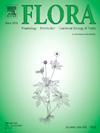黄花菜的繁殖成功。花开花:适应性泛化的证据
IF 1.8
4区 生物学
Q3 ECOLOGY
引用次数: 0
摘要
植物和传粉者之间的相互作用是由花的特征决定的,这些特征的组合决定了传粉系统的专业化水平。具有通才系统的植物预计会表现出较少的限制性性状,并从不同的来访者那里获得相似的生殖贡献。例如,更长的花寿命可能会促进更广泛的来客授粉,从而导致泛化。本文研究了巴西Campos Rupestres(岩石露头)中花期的传粉动态(访花者、性状变化、繁殖成功率)。该物种有刷子状的花,产花蜜,在花期改变颜色。白天有蜂鸟和蜜蜂,晚上有蝙蝠和飞蛾。花期花色和花蜜分泌同步变化。夜间花蜜产量高,花是白色的,能吸收紫外线,因此比白天访问频率更高。然而,在花的整个生命周期中,柱头上的聚体去除和沉积仍然很高,表明昼夜传粉者和夜间传粉者都对授粉有贡献。然而,水果和种子产量一直很低,表明营养有限。研究结果表明,花的寿命延长与花的传粉系统泛化程度的提高有关。白天和夜间传粉者的相似贡献表明适应性泛化,其中花性状与更广泛的访问者多样性和更高的繁殖成功率有关。本文章由计算机程序翻译,如有差异,请以英文原文为准。
Reproductive success over Calliandra fasciculata Benth. floral anthesis: evidence of adaptive generalization
Interactions between plants and pollinators are shaped by floral traits, and the combination of these characteristics determines the level of specialization in pollination systems. Plants with generalist systems are expected to exhibit less restrictive traits and receive similar contributions from different visitors to their reproduction. For instance, greater floral longevity may enhance pollination by a wider range of visitors, leading to generalization. In this study, we investigated the pollination dynamics (floral visitors, changes in traits, reproductive success) along the floral longevity of Calliandra fasciculata in the Brazilian Campos Rupestres (rocky outcrops). The species has brush-shaped flowers, produces nectar, and changes color during anthesis. It was visited by hummingbirds and bees during the day, and by bats and hawkmoths at night. Flower color and nectar secretion changed synchronously during anthesis. High nectar production at night, when flowers are white and absorb UV, led to a higher frequency of visits than during the day. However, polyad removal and deposition on stigmas remained high throughout the floral lifespan, indicating that both diurnal and nocturnal pollinators contribute to pollination. Yet, fruit and seed production were consistently low, suggesting nutritional limitation. Our results indicate that extended floral longevity is associated with increased generalization in the pollination system of C. fasciculata. The comparable contribution of day and night pollinators suggests adaptive generalization, in which floral traits are linked to broader visitor diversity and enhanced reproductive success.
求助全文
通过发布文献求助,成功后即可免费获取论文全文。
去求助
来源期刊

Flora
生物-植物科学
CiteScore
3.30
自引率
10.50%
发文量
130
审稿时长
54 days
期刊介绍:
FLORA publishes original contributions and review articles on plant structure (morphology and anatomy), plant distribution (incl. phylogeography) and plant functional ecology (ecophysiology, population ecology and population genetics, organismic interactions, community ecology, ecosystem ecology). Manuscripts (both original and review articles) on a single topic can be compiled in Special Issues, for which suggestions are welcome.
FLORA, the scientific botanical journal with the longest uninterrupted publication sequence (since 1818), considers manuscripts in the above areas which appeal a broad scientific and international readership. Manuscripts focused on floristics and vegetation science will only be considered if they exceed the pure descriptive approach and have relevance for interpreting plant morphology, distribution or ecology. Manuscripts whose content is restricted to purely systematic and nomenclature matters, to geobotanical aspects of only local interest, to pure applications in agri-, horti- or silviculture and pharmacology, and experimental studies dealing exclusively with investigations at the cellular and subcellular level will not be accepted. Manuscripts dealing with comparative and evolutionary aspects of morphology, anatomy and development are welcome.
 求助内容:
求助内容: 应助结果提醒方式:
应助结果提醒方式:


